Please Take Note: This is a review of the game’s final prototype. The art, game bits, and the rules discussed are all subject to change. The game is being reviewed on the components and the rules provided with the understanding that “what you see is not what you might get” when the game is published. If you like what you read and want to learn more, we encourage you to visit the game’s web site or visit the Kickstarter campaign. Now that we have all that disclaimer junk out of the way, on with the review!
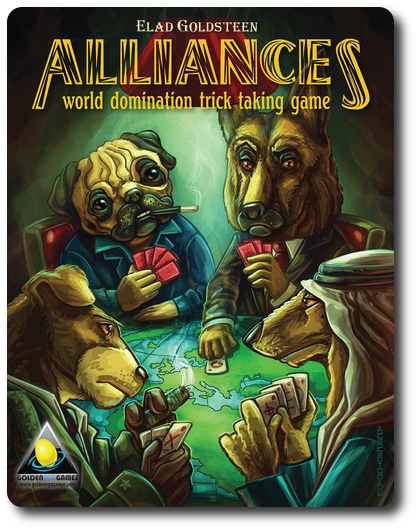
The Basics:
- For ages 8 and up
- For 2 to 4 players
- Approximately 45 minutes to complete
Geek Skills:
- Counting & Math
- Logical & Critical Decision Making
- Reading
- Strategy & Tactics
- Risk vs. Reward
- Cooperative & Team Play
- Hand/Resource Management
- Auctioning & Bidding
- Area Control
Learning Curve:
- Child – Easy
- Adult – Easy
Theme & Narrative:
- Persuade other countries to see it “your way” by using political, economical, or militant power
Endorsements:
- Gamer Geek approved!
- Parent Geek approved!
- Child Geek approved!
Overview
John Kenneth Galbraith, an economist, public official, diplomat, and a leading proponent of 20th-century American liberalism, said, “Politics is the art of choosing between the disastrous and the unpalatable.” If that is the case, then the world political stage is a smorgasbord of rotten and slightly tolerable results. The same cannot be said about this game of political intrigue, power, and persuasion where players attempt to conquer and control one country at a time.
Alliances, designed by Elad Goldsteen and to be published by Golden Egg Games, will reportedly be comprised of 36 Power cards (12 cards each in 3 different suits), 12 Special Action cards (4 cards each in 3 different suits), 20 Country tiles, 32 Alliance tokens (16 each in 2 different colors), and 1 Conflict token. Not included in the game, but necessary to play, is a pen or pencil and a pad of paper. As this is a review of a prepublished game, we will not comment on the game component quality. What was provided, along with the rules, was complete and very easy to play with.
The Tools of Politics
The game components deserve a bit of an explanation. While small in number, it is very important from the very start to the very end of the game to know how the game components work together.
Country Tiles
These tiles represent, in an abstract manner, the countries that each of the players will be attempting to control. Each Country tile will show the necessary Political, Military, and Economic power that must be used to influence its allegiance towards one alliance versus another. A number next to a specific power indicates the country’s internal resistance that must be overcome by the players to control the Country tile.
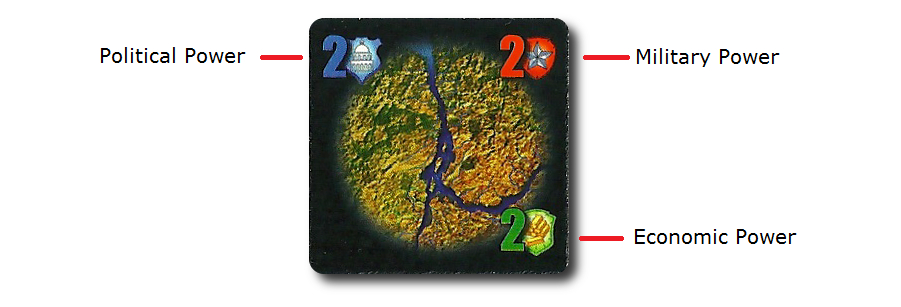
The Power Cards
The Power cards are just that, but they represent different kinds of influence. Each Power card will either represent a player’s Political, Military, or Economic power they are using during an attempt to influence a country. But a player’s power is not unlimited. A wise politician knows that the best way to play the game on the world stage is to never let your opponent see you coming and always keep them guessing!
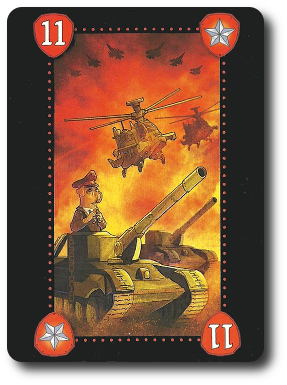
The Special Action Cards
The Special Action cards, like the Power cards, represent different kinds of influence, but are much more specific. While the Power cards represent a player’s overall and nondescript use of one of the three influences, the Special Action cards narrow the player’s influence down. However, such cards are also dependent on the overall political, militant, and economical environment the country and the player’s opponents are creating. Timing is even more crucial with the Special Action cards and sometimes it makes the most sense to hold them close until the very last possible moment for the greatest impact on game play.

Game Set Up
Note: The game can be played with 2, 3, or 4 players. The following game set up and game play summary is for a 4-player game were 2 players work as a team. The other ways to play the game are summarized in the Game Variant section below.
To set up the game, first determine which players will be a team (an alliance) and have them sit across from each other. In this way, the turn order sequence will alternate from one team to another as the game continues around the table going clockwise.
Second, shuffle the Country tiles and randomly place them down in the middle of the playing area, face-up, in 4 rows of 5 tiles each. Leave enough room between the tiles, rows, and columns so that each Country tile is easily distinguishable from the other.
Third, each player now takes 3 Alliance tokens for their team’s color and places them on the three Country tiles on each corner. See below image for a visual example. The remaining Alliance tokens can be placed to the side, but should remain in easy reach of all the players.
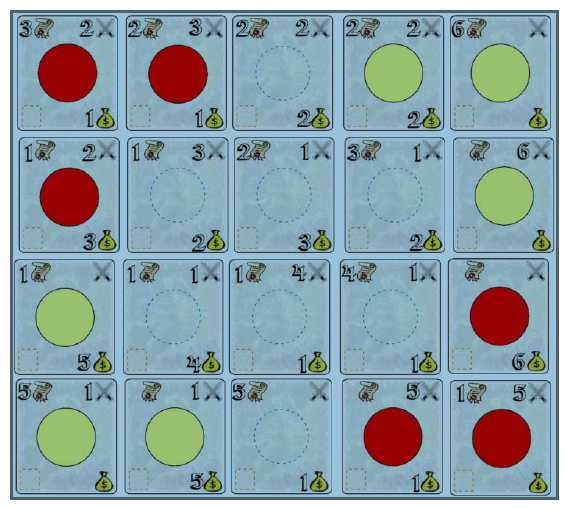
Fourth, shuffle the deck of cards and deal out to each player 12 cards, face-down. Players should keep their cards hidden at all times.
That’s it for game set up! Let the battle begin!
The War of Politics
The game is played in 12 rounds with each round being comprised of 2 phases. A completed set of 12 rounds is referred to as a “campaign”. The phases of each round are summarized here.
Phase 1: State of the Nations
During this phase, all the players will bid on the number of Country tiles they think their alliance will be able to control at the end of the campaign. Each player will announce a number (10 through 20) and a dominate suit that will be trump for the campaign (Politics, Military, or Economics). The bidding starts with a random player and then goes clockwise. Each subsequent bid must have a higher number of Country tiles or a use the same number of Country tiles, but use a higher ranked suit (with the lowest being Military, the next highest being Economic, and the highest being Political).
For example, if Player A stated, “12 countries using Military power”, Player B could say, “13 countries using Military power” or “12 countries using Economic power”.
A player is always welcome to “Pass” on their turn, but this locks them out for the duration of the phase; however, their alliance partner can continue to bid. Once all the players pass, the highest bid and trump is recorded and the player who provided it is the first player. The alliance that has the highest bid is the “aggressor” for the campaign with the other alliance being the “defenders”. This ends the first phase.
Phase 2: Conflict
Now the game is played in earnest. The aggressors’ main goal is to control at least the number of Country tiles stated in the bid. Failure to do so will award the campaign victory to the defenders.
The Conflict phase is broken into 12 rounds of play (one round per card originally dealt to each player during game set up). The first player will decide which Country tile is being contested over by placing the Conflict token on a Country tile that is “neutral” (a Country tile that does not yet have an Alliance token on it) and is adjacent to a Country tile the player’s alliance currently controls. The one exception to this rule is when there are no more “neutral” countries to be had, in which case the player can select any Country tile that is currently controlled by their opponent’s alliance but is still adjacent to the player’s alliance controlled Country tile.
Once selected, the starting player will play a card from their hand out in front of them, face-up. The suit of the leading card will determine the suit that must be played by the players. The next player must either play a Power card of the leading suit, any Special card of the leading suit, or any Power or Special card of a different suit (but only if the player does not have any card of the leading suit). Power cards, once played, do not require any additional action on the players’ part. Special Action cards might require an action that must be resolved once the card is played.
After all the players have played their cards to the table, the winner of the round is now determined. This is done by first calculating the hand power of the two different alliances. Power cards provide a number, but Special Action cards might have a value that is determined based on other cards played and the Country tile being contested over. Only cards that are of the leading suit count towards an alliance’s total hand power, but if a player used a card with the dominate suit (the trump determined in phase 1), the leading suit is ignored and the total hand power using the “trump” suit is the only one counted.
Once the total hand power of both alliances are determined, the alliance with the highest total wins the conflict phase. In case of a tie, the aggressors only win the conflict phase if the aggressive alliance has more Alliance tokens in play than the defenders.
The hand power of the winning alliance with the suit used is then compared to the Country tile. if the value of the hand power is HIGHER than the Country tile’s suit value used, the alliance takes one of their Alliance tokens and places it on the Country tile. This happens even if the alliance already controlled it or if their rivals did. In this way, Alliance tokens are stacked on top of each other.
All the cards played are then discarded and the winner of the conflict phase will be the first player, but only if they claimed the Country tile. If not, the first player is the next player going clockwise. Play now continues for all 12 rounds.
Global Domination
After 12 rounds, all the Alliance tokens are now counted. If the aggressor alliance controls at least the number of Country tiles stated in the bid, they win the campaign. If not, the defenders do. In case of a tie, count all the Alliance tokens in play (including all those that have tokens on top of them). The side that has the most Alliance tokens wins the campaign.
The game now continues with all the cards and tiles being collected, shuffled, and set up as noted above. After 3 campaigns (or if a team wins 2 victories in a row), the team with the most campaign wins is declared the winner!
Game Variants
The game comes with several different variants that can be used to change the game play. Most variants provide a slightly different way to play the game. In Alliances, the game variants are different enough to make the overall game playing experience feel very different. Depending on the number of players, each game playing session will be unique and requires some big shifts in a player’s tactics and strategy. They are summarized here.
- Drafting: instead of handing each player 12 cards to play with that they control right from the start, each player is dealt 12 cards, chooses 2 cards to keep, and then passes the rest of the hand to the player to their left. Then the process is repeated until each player has 12 cards in their hand. This is a good game variant to use to reduce the impact of luck and increase more strategic game play.
- Two-Player Game: the game set up is the same as note above, with the undealt cards remaining as a draw deck, and with very different game play style. The first phase (referred to as the “Drafting phase”) lets the first player play a card, face-up, that their opponent must then match via the same suit. Then both players draw a new card to put in their hand. This continues until there are no cards left to draw. The Conflict phase is played much the same as noted above with a few exceptions. Refer to the rules for full details.
- Three-Player Game: the game set up remains largely the same (with the one exception being all the cards are dealt evenly amount the players), but the game length is exactly 3 campaigns long instead of the “best of 3”. Instead of “aggressor” and “defender”, the players will be playing as “rebels” and “empire”. Only the player who is currently the playing as the “empire” can score points. Game play is very different and focuses on total victories for each player to determine the overall winner. Refer to the rules for full details.
For additional details on the game and read the full rules, visit the game’s web site or visit the Kickstarter campaign.
Prediction
My family and friends are very familiar with trick-taking card games. Very familiar. In fact, card games that use the same game mechanisms found in Alliances remain exceedingly popular with the Child and Parent Geeks, including the non-gamers. I predict Alliances will do very well with this crowd, despite its theme. Wargames and games that focus on combat can at times make some of the Parent Geeks nervous. I doubt Alliances will even raise an eyebrow as the game’s theme is there in the background only. No more and no less than the classic card game, War. At most, I expect the Parent Geeks to snicker at the artist’s political satire.
For the Gamer Geeks, I am at a crossroads when it comes to my prediction. On one hand, Alliances is at its core a very simple trick-taking game. While popular with the Child and Parent Geeks, the Gamer Geeks see this game mechanism as somewhat boring and overly used. Not that they are against it, mind you, but they do find it rather uninteresting and unimaginative. Since trick-taking plays such a large part of the game, I fear the Gamer Geeks might not be fully on-board with the game due to its lack-luster approach to conflict management. On the other hand, Alliances utilizes the ho-hum trick-taking mechanisms in parallel to area control and resource management. These are two game mechanisms the Gamer Geeks have always enjoyed. Especially when put together. Such games often require their players to spend much more time thinking through their card plays, and as a result, easily allow for a player to come up with their own tactics and strategy.
It’s a toss-up, I suppose. I think what will ultimately persuade the Gamer Geeks is their overall game playing experience at the table with others AND the type of game they play. Alliances really is 3 different games in one box. Depending on the number of players at the table, the difference in game play, necessary tactics, and overall strategy can radically shift.
Teaching the game is pretty straight forward, but I strongly suggest you introduce the game when you have 4 players. The 4-player standard game is by far the easiest to learn and the most fun for new players. Victory and defeat is shared and the level of table talk and body language can be deafening at times. Do spend a moment or two discussing the Special Action cards and make sure that all the players understand their usage. To be honest, the icons on the Special Action cards are not at times fully understandable. A quick explanation of each will go a long way. There are only 12, so it shouldn’t take long.
After teaching the game to my two oldest little geeks, it was decided that my 5-year-old would be my partner and my 8-year-old was more than capable of playing on his own. Alliances does require the player to be able to read and to memorize the meaning of the icons on the cards. For most players who have been playing games for over a year, none of the game play should be too complicated to grasp. Even our non-gamers “got the game” once we explained it to them. But for Child Geeks, everything is still very new and often times difficult. Teaming a Child Geek with a Parent Geek is not only a great way to include the less experienced players, but also provides fantastic quality time. And so, after answering all the questions from my little geeks, I asked them their thoughts on the game so far.
“I really like this! It reminds me of other games we have played. I won’t have any problems playing it.” ~ Liam (age 8)
“I know how to play the Power cards, Daddy. Your job will be the cards with words.” ~ Nyhus (age 5)
Let’s play Alliances and see if it brings the gaming groups together or rips them apart.
Final Word
Alliances was a wonderful game to play with the Child Geeks with 4 players. One Child Geek and one Parent Geek teamed against another Child/Parent Geek team. All the Child Geeks we played the game with in a 4-player game had a wonderful time and enjoyed themselves from start to finish. The same could not be said for a 3-player game, that more or less pitted a Child Geek against 2 opponents for an entire campaign. When the Child Geeks were with a partner, they enjoyed it, but when it came their turn to be the empire, they felt outmatched and outnumbered. Which they were. The 2-player game was enjoyed by the Child Geeks, but only by those who already enjoyed more complex games that required more concentration and time. Truly, there was something for every Child Geek and they all voted to approve it. Even if they didn’t like one particular game variant, they were more than happy with another.
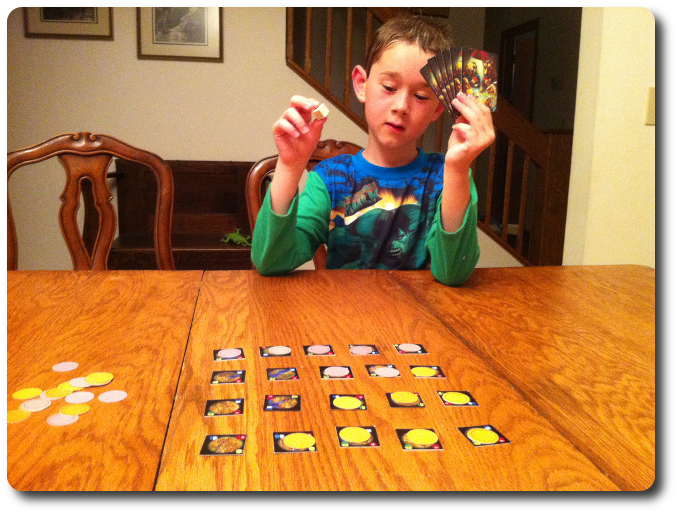
My little geek contemplates his next target during a 2-player game
The Parent Geeks also had a wonderful time with Alliances. The biggest win was for the Parent Geeks who teamed up with their Child Geeks and, surprisingly enough, the non-gamer Parent Geeks. This seldom discussed and often times disgruntled sub-group really enjoyed Alliances. The more traditional card game players did the best and were surprisingly strong players when it came to their turn during the game, be it in a 4, 3, or 2-player game variant session. All the Parent Geeks agreed that Alliances was a wonderful game for the family and to play with their peers. And, yes, they all smirked at the obvious political satire.
The Gamer Geeks played Alliances a few times during our lunch breaks at the office, and after the 3rd game, declared it was an “excellent game for lunch breaks, before big games, and anytime you just wanted to play a game worthwhile.” And I’m quoting here. What the Gamer Geeks really enjoyed most was how quickly the game could be played, how interesting the game play was, and how much fun it was to skunk your opponents. The simple and rather old hat game mechanisms in the game only served to make the game much more easy to play instead of what I feared would be a certain level of boredom. Just the opposite, in fact. One Gamer Geek said, “What makes this game so much fun is that it feels familiar, but keeps you guessing and thinking right from the start.” All the Gamer Geeks agreed that Alliances was an excellent filler game or whenever a Gamer Geek wanted a quick game that still required them to use strategy and tactics to win.
My favorite way to play Alliances is with 3 or 4-players. The 3-player game variant can be downright brutal with 2 players against one that is best described as a “tentative and very temporary alliance”. The 4-player game let’s me play some neat combos with my partner and there is much comradery, high-fiving, and sarcastic questions regarding “obviously dumb card play” to be had. I found the 2-player game to be OK, but it felt a bit forced at times, or better put, a bit less interesting than the 3 and 4-player games. Still a lot of fun, though, but it can’t compete with the levels of excitement, strategy, and tactics used in the 3 and 4-player game.
Alliances doesn’t have a lot of depth. Normally, you’d think that was something of a negative, but not in this case. Instead of depth, I would suggest that Alliances has tiers of focus. The first tier is the player’s hand that they must manage and the bid. The second is the Country tile the player is currently playing for. The third and final tier is the campaign. Now I know that sounds like a lot to consider and would strongly suggest depth, but each tier is only as important as the player’s current position. That being “aggressor” or “defender”. This is where the game looses it’s depth, but none of its focus. As an aggressor, you must focus on the first and second tier at all times. It doesn’t matter if you lose a country as long as you have the majority and you know exactly what number of countries you need to win. As a defender, you must focus fully on the second tier and individual countries. The specific focus a player will need to concentrate on will shift after each campaign, but the depth of play is always the same.
And yet, Alliances does require a lot of strategy and tactics, not to mention a lot of savvy card playing with a healthy mix of good timing. Each card is a resource that could mean losing the battle or winning the war. A player must really think through their moves if they hope to win, but more importantly, be fully willing to lose a battle to win the war. Individual conflicts don’t mean a thing; only the final result of the campaign. If a player recognizes this, they will be a worthy and difficult adversary right from the start and keep their opponent guessing. Did they lose on purpose or did they not have the cards? What are they planning next? Do they have a card that will stop me in my tracks? Guessing how a player will come at you and react to your cards is as much fun as playing the game and will keep everyone engaged from start to finish.
I highly recommend Alliances to friends and family for its simple, quick, and engaging game play. It’s a lot of fun and tailors itself well to mixed number of players, providing a different game playing experience for each. There is never a great deal to consider during the game, but each card play feels exceedingly important. I had a great time playing it and look forward to playing it again soon.
This game was given to Father Geek as a review copy. Father Geek was not paid, bribed, wined, dined, or threatened in vain hopes of influencing this review. Such is the statuesque and legendary integrity of Father Geek.



